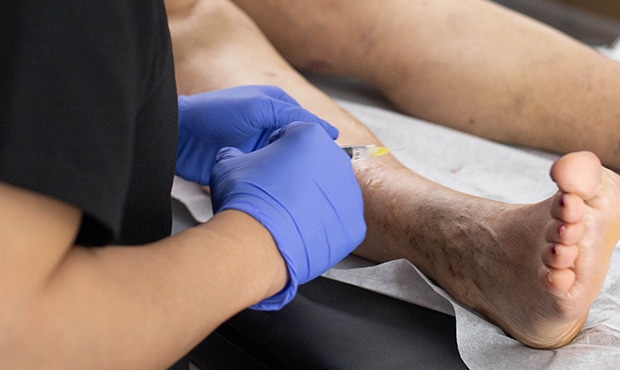Summary of vein treatment procedure at vein clinic in Freeport, Long Island.
If you have spider veins or varicose veins, you may wonder what happens during a vein treatment process. Most of our patients are initially terrified of venous insufficiency and vein treatment until we explain what the procedure entails. Once you see how simple and minimally invasive vein treatments are, you’ll realize that you have no cause for concern.
Vein Treatment Clinic is a state-of-the-art vein clinic in Freeport, Long Island, that provides the safest minimally invasive vein treatments. Our vein doctors use vascular imaging to diagnose the root cause of varicose veins and spider veins to curate the ideal treatment plan for your needs.
Our vein clinic is located in a little town called Lindenhurst, approximately 15 minutes from Freeport via NY-27E and NY-27A. Alternatively, our vein clinic is approximately 20 minutes from Freeport via Southern State Pkwy, located right next to the Bergen Point Golf Course.
Now that you know how to reach our vein clinic, all you have to do is schedule your vein treatment. If you have any concerns or fears, lay them to rest by reading this article on what to expect from a vein treatment at our vein clinic in Freeport, Long Island.
Broadly speaking, vein treatment at our vein clinic in Freeport consists of the following steps:
- Step 1: Examination of varicose veins and spider veins.
- Step 2: Diagnosis of venous insufficiency.
- Step 3: Minimally invasive venous disease treatments.
- Step 4: Minimally invasive treatments for superficial varicose veins and spider veins.

Step 1: Examination of varicose veins and spider veins.
Like all medical consultations, the first step of the treatment process is a visual and physical examination. The vein doctor will examine your varicose veins and spider veins, identifying all visible symptoms of venous insufficiency.
Spider veins may or may not be symptomatic of venous disease. However, varicose veins are always caused by underlying chronic venous insufficiency, a circulatory disorder in which your vein valves collapse and blood accumulate in your leg veins.
Over time, the continued blood accumulation in leg veins leads to vein dilation, resulting in spider veins and varicose veins. Spider veins are dense clusters of blood vessels visible just under the skin. Varicose veins are large knotted blood vessels that took like a mass of twisted ropes.
The vein doctor must determine if you have venous insufficiency before they can curate a treatment plan.
Step 2: Diagnosis of venous insufficiency.
After the visual and physical examination, the vein doctor will need to identify the diseased saphenous vein that’s causing all the vein problems. That’s where vascular imaging comes in.
Through vascular imaging — a process called Duplex Ultrasound — the vein doctor visualizes the blood flow in your leg veins. This allows the vein doctor to determine if you have vein disease and identify the diseased saphenous vein.
After diagnosing venous insufficiency, the vein doctor can finally curate a vein treatment plan for your specific needs.
Step 3: Minimally invasive venous disease treatments.
After the diagnosis, the vein doctor will discuss all of your minimally invasive vein treatment options. The vein doctor will give you three options — radiofrequency ablation, endovenous laser ablation, and VenaSeal.
During radiofrequency ablation, the vein doctor drives a catheter through an incision on the skin, using ultrasound guidance to lead it into the diseased saphenous vein. Once the catheter is inside the saphenous vein, the vein doctor activates it to generate thermal energy. The diseased vein collapses and gets absorbed by the body.
During endovenous laser ablation, the vein physician drives a laser fiber through an incision on the skin, using ultrasound guidance to lead it into the problematic saphenous vein. Once the endovenous laser is inside the saphenous vein, the vein doctor will use laser energy to collapse the vein’s walls. The diseased vein will break and eventually get absorbed by the body.
During VenaSeal, the vein doctor will inject a medical adhesive into the diseased saphenous vein under ultrasound guidance. The diseased vein’s walls will seal shut, harden, and eventually get absorbed by the body.
As you can see, all minimally invasive vein treatments have the same goal — collapse the diseased saphenous vein, rerouting the accumulated blood to healthier veins. However, they go about it in different methods.
Endovenous laser ablation causes a little more post-procedural discomfort than the others. And VenaSeal is the only one of these vein treatments not covered by insurance. All of them, however, are minimally invasive and non-surgical procedures that conclude within an hour with no significant complications or side effects.
Step 4: Minimally invasive treatments for superficial varicose veins and spider veins.
The primary vein treatment will address the underlying venous disease, collapsing the problematic saphenous vein and restoring blood circulation. But it won’t remove all of the visible varicose veins and spider veins from your skin. That’s where ambulatory phlebectomy and sclerotherapy come in.
Ambulatory phlebectomy is a minimally invasive vein treatment in which the vein doctor removes the superficial varicose veins through incisions on the skin.
Sclerotherapy is a minimally invasive vein treatment in which the vein doctor injects a medicine into the spider veins to fuse their vein walls. The spider veins turn into scar tissues that eventually get absorbed by the body.
Ambulatory phlebectomy and sclerotherapy are cosmetic vein treatments because they only remove the visible and harmless veins without addressing the underlying vein disease. As such, they aren’t eligible for insurance coverage.
Schedule an Appointment with our Vein Clinic in Freeport
Vein Treatment Clinic believes in the vein care philosophy that your emotional comfort is just as important as your physical comfort. For more information, please schedule an appointment with our vein clinic in Freeport, Long Island, today.